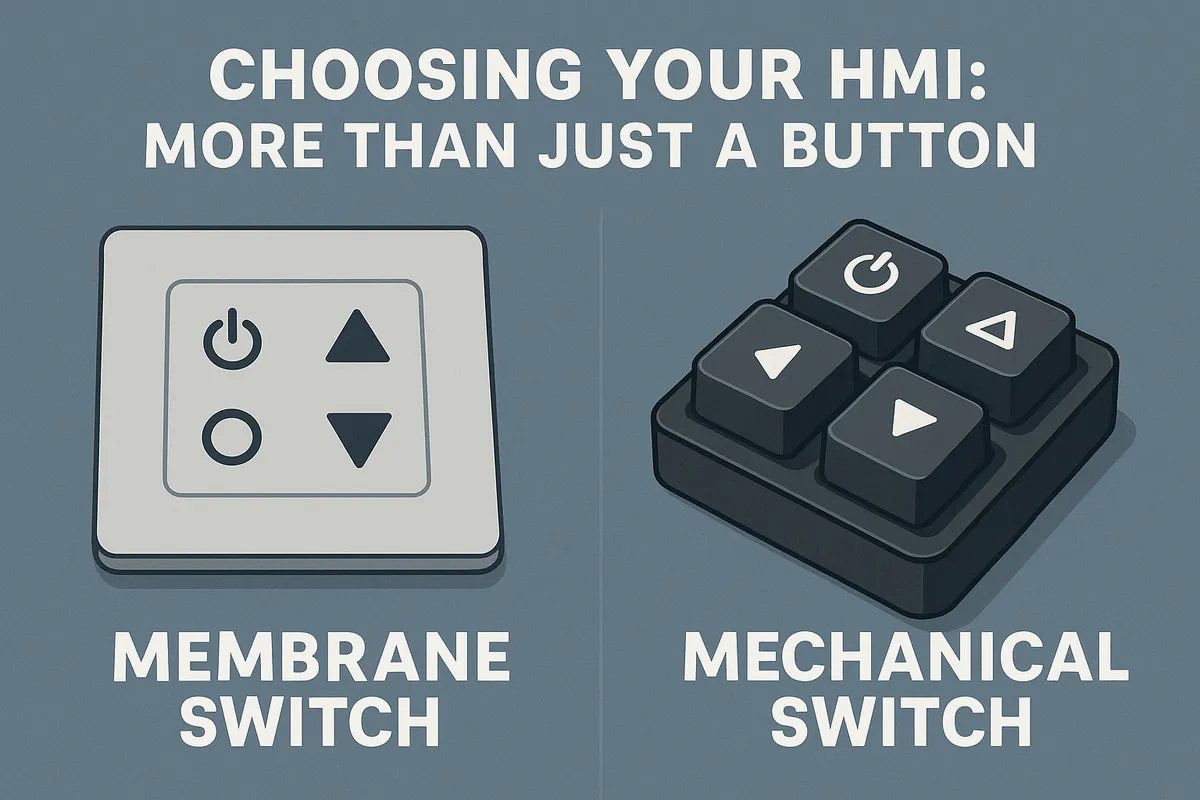Membrane Switch vs. Mechanical Switch: Which is Right for Your HMI?
For years, engineers have weighed the pros and cons of two primary technologies: traditional mechanical switches and modern membrane switches. While both can accomplish the same basic function, their underlying construction leads to vastly different performance characteristics.

Choosing Your HMI: More Than Just a Button
When designing a product, the Human-Machine Interface (HMI) is a critical decision that impacts user experience, durability, and manufacturing costs. For years, engineers have weighed the pros and cons of two primary technologies: traditional mechanical switches and modern membrane switches. While both can accomplish the same basic function, their underlying construction leads to vastly different performance characteristics. Understanding these differences is key to selecting the right technology for your application, whether it’s a medical device, an industrial controller, or a consumer appliance.
Key Differences at a Glance
This table provides a high-level comparison of the core attributes of each technology.
| Feature | Membrane Switch | Mechanical Switch |
|---|---|---|
| Sealing & IP Rating | Excellent; easily sealed for high IP ratings (IP65/67). | Poor; difficult and expensive to seal against dust/water. |
| Profile & Thickness | Very low profile (typically 1-2 mm). | Bulky; requires significant depth behind the panel. |
| Customization | Highly customizable graphics, colors, and layout. | Limited to standard button shapes, sizes, and legends. |
| Lifecycle | 1-5 million actuations, depending on design. | 50k to 10+ million, depending on switch type. |
| Cleaning & Sterilization | Excellent; smooth, non-porous surface is easy to clean. | Difficult; crevices between keys trap contaminants. |
| Unit Cost at Scale | Lower, especially for custom layouts with many buttons. | Higher, as each switch is an individual component. |
| Tactile Feedback | Customizable (non-tactile, poly-domes, metal domes). | Strong, inherent “clicky” feedback. |
When to Choose a Membrane Switch
Membrane switches excel in applications where reliability, cleanability, and customization are paramount.
Environment & Sealing
This is the most significant advantage of membrane switch technology. Because they are constructed from sealed layers of polyester and adhesive, they are inherently resistant to moisture, dust, chemicals, and other contaminants. A well-designed membrane switch can easily achieve an IP67 rating, making it suitable for outdoor use, factory floors, and medical environments where frequent wipe-downs with harsh cleaning agents are required.
Profile & Integration
The slim profile of a membrane switch allows for sleek, modern product designs. It can be applied directly to a product’s housing, saving significant internal space compared to the bulky architecture of mechanical switches. This simplifies assembly and allows for more compact product footprints.
Customization & Branding
With a membrane switch, the entire front panel is a blank canvas. The graphic overlay is digitally or screen-printed on the reverse side, meaning legends, logos, and colors will never wear out from use. This allows for complete brand control and the creation of intuitive, icon-driven user interfaces at no significant extra cost. Features like transparent display windows or custom backlighting are also easily integrated.
When Mechanical Switches Still Make Sense
Despite the advantages of membrane technology, mechanical switches remain relevant for specific use cases.
- Extreme Tactile Feedback: For applications where an unmistakable, heavy-duty “clunk” is necessary (e.g., an emergency stop button), a high-force mechanical switch is often preferred.
- Existing Modular Designs: In some control panels, individual, field-replaceable switches are a requirement, favoring a modular mechanical setup.
Making the Right Choice for Your Application
For most modern industrial, medical, and commercial products, the benefits of membrane switches—superior sealing, design freedom, and a lower total cost of ownership—make them the preferred choice. They provide a reliable and cost-effective path to creating a durable, custom HMI that protects the sensitive electronics underneath. Engaging with a full-service manufacturer like G&D Elektronik can help you explore the various tactile options, material choices, and integrated features to build the ideal interface for your product.
Frequently Asked Questions (FAQ)
Can a membrane switch have the same “clicky” feel as a mechanical one? Yes, by using metal domes beneath the graphic overlay, a membrane switch can provide distinct tactile and audible feedback that confirms actuation for the user. Different dome shapes and sizes offer varying levels of force and feedback.
Are membrane switches durable enough for industrial environments? Absolutely. With the right materials, such as hard-coated polyester overlays and strong 3M adhesives, membrane switches are designed to withstand abrasion, chemical exposure, and millions of actuations, making them ideal for rugged applications.
What is the cost difference? While the upfront tooling cost for a custom membrane switch may be higher, the unit price at production volumes is typically much lower than the equivalent number of individual mechanical switches, especially when you factor in the reduced assembly time.
